Getting started
Welcome to Gobley! Gobley is a set of libraries and tools that help you mix Rust and Kotlin, so you can focus on implementing your business logic. In this tutorial, you will learn how to embed Rust code into your Kotlin Multiplatform project using Gobley. If you have trouble setting up your project, please create a question in GitHub Discussions.
Prerequisites
To develop with Kotlin Multiplatform, you need:
- An IDE for Android development, such as Android Studio or IntelliJ IDEA.
- (Optional) The IDE for iOS development: Xcode.
You'll spend much time with Android Studio or IntelliJ IDEA to code in Kotlin. Xcode is required to build iOS apps.
To develop in Rust, you need:
- A Rust toolchain.
- An IDE for Rust. Several options are available:
- Visual Studio Code with
rust-analyzer. - RustRover.
- IntelliJ IDEA Ultimate with the Rust plugin.
- Other editors like Vim. Still, using
rust-analyzeris recommended.
- Visual Studio Code with
You'll use a separate IDE for Rust development. The only way to use a single IDE is IntelliJ IDEA Ultimate, but it needs a paid subscription.
Creating a Kotlin Multiplatform project
Let's first create a new Kotlin Multiplatform project. Please read the official documentation for more details about how Kotlin Multiplatform works.
- Visit the Kotlin Multiplatform Wizard website.
- On the New Project tab, set the Project Name and Project ID to names you want. Let's
use
MyFirstGobleyProjectanddev.gobley.myfirstproject. - Make sure you selected Android and iOS.
- Select Share UI (with Compose Multiplatform UI framework). You can use Gobley without Compose Multiplatform, but let's focus on how to mix Rust and Kotlin this time.
- Click the Download button and extract the downloaded
.zipfile. - Launch Android Studio or IntelliJ IDEA, and open the extracted folder.

Adding Rust to your Kotlin Multiplatform project
Let's add a Cargo package to the Kotlin Multiplatform project.
-
Make sure you installed
cargoandrustup. -
Open the Terminal menu in Android Studio or IntelliJ IDEA. Run:
cargo init --lib --name compose-app --vcs none composeAppLet's see what this command does:
cargo initwill create a new Cargo package incomposeApp.--libmeans that Cargo will create a library crate.--name compose-appmeans that the name of the resulting Cargo package will becompose-app. Cargo doesn't like camelCase.--vcs nonemeans you don't want to generate.gitor.gitignore.composeAppis the directory where we'll code both in Rust and Kotlin.
After running this command, the following files should be generated:
composeApp/Cargo.toml: This file contains the definition of the Cargo package.composeApp/src/lib.rs: The Rust source code file.
-
Add
**/target/to.gitignore.💡 This is the folder where Cargo stores the build intermediate files and the final Rust library.
-
(Optional) Move
composeApp/src/lib.rstocomposeApp/src/commonMain/rust/lib.rs.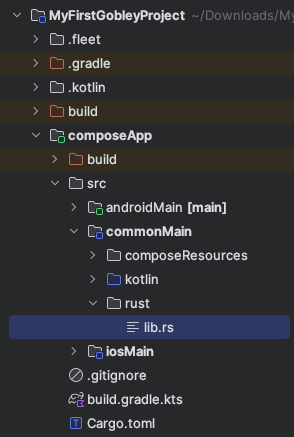
💡 When you use CMake in an Android project, C++ source files are usually located in
src/main/cpp. This procedure imitates that behavior. It feels more organized, isn't it? -
Modify
composeApp/Cargo.tomllike the following.# This part is already added by cargo init.
[package]
name = "compose-app"
version = "0.1.0"
edition = "2024"
[dependencies]
# We need to add this.
uniffi = "0.28.3"
# This as well.
[lib]
crate-type = ["cdylib", "staticlib"]
# Put this only if you moved lib.rs.
path = "src/commonMain/rust/lib.rs"Let's see what each part of the modification does:
uniffi = "0.28.3"downloads UniFFI, the library used to generate the Kotlin code (the " bindings") that calls the Rust library.crate-type = ["cdylib", "staticlib"]will make Cargo generate a.a(static library) file and a.so/.dylib(dynamic library) file that can be used by Gobley. Gobley uses the static library file when building for iOS, and the dynamic library file for Android.path = "src/commonMain/rust/lib.rs"designates the path to the Rust source code.
-
Add an empty file,
composeApp/uniffi.toml.💡 You can configure various binding generation options here.
-
Modify
composeApp/build.gradle.ktslike the following.plugins {
// Other plugins here
id("dev.gobley.cargo") version "0.1.0"
id("dev.gobley.uniffi") version "0.1.0"
kotlin("plugin.atomicfu") version libs.versions.kotlin
}
uniffi {
generateFromLibrary()
}❗ Consider managing plugin dependencies using version catalogs.
💡 All Gradle plugins in Gobley are published in
mavenCentral().Let's see what each plugin does:
dev.gobley.cargobuilds and links the Rust library to the Kotlin application.dev.gobley.uniffigenerates the bindings using UniFFI. Theuniffi {}block is to configure binding generation options. Since we usedgenerateFromLibrary()this time, the bindings will be generated automatically from the Rust library.org.jetbrains.kotlin.plugin.atomicfuis to use atomic types used by the bindings.
We're now ready to code both in Rust and Kotlin! Press the Sync Now button to make the IDE download the Gradle plugins.
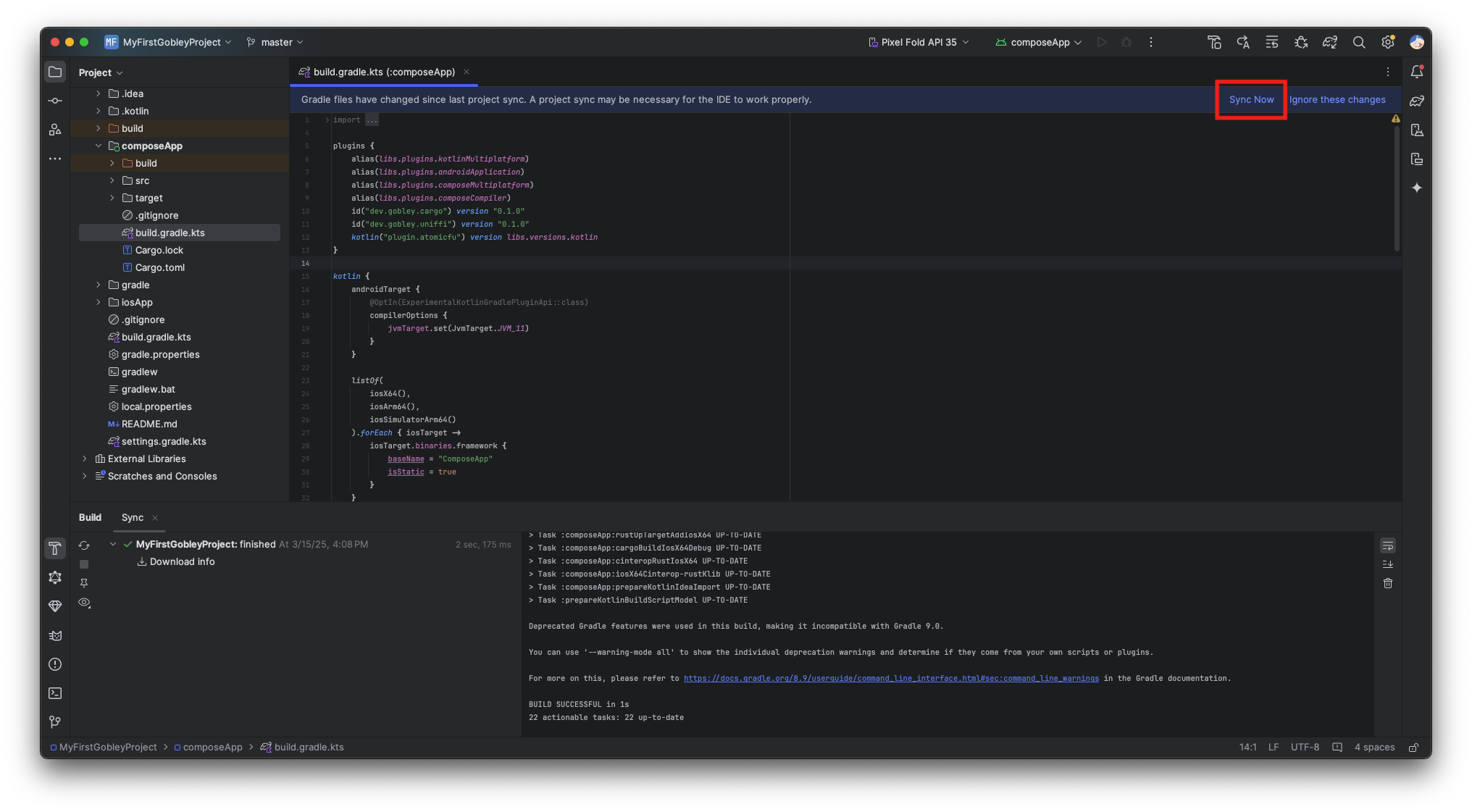
Defining and exposing Rust types and functions
Now is the time to code in Rust. Open composeApp in Visual Studio Code. Once rust-analyzer is
ready, you can see highlightings and inlay hints in the code editor. Modify
src/commonMain/rust/lib.rs as follows.
/// This exports this Rust function to the Kotlin side.
#[uniffi::export]
fn add(lhs: i32, rhs: i32) -> i32 {
lhs + rhs
}
/// This exports this Rust type to the Kotlin side.
#[derive(uniffi::Object)]
struct Greeter {
greeting: String
}
#[uniffi::export]
impl Greeter {
/// Define a constructor to be used on the Kotlin side.
#[uniffi::constructor]
fn new(greeting: String) -> Self {
Self { greeting }
}
/// Define a method to be used on the Kotlin side.
fn greet(&self, name: String) -> String {
format!("{}, {name}!", self.greeting)
}
}
// This generates extra Rust code required by UniFFI.
uniffi::setup_scaffolding!();
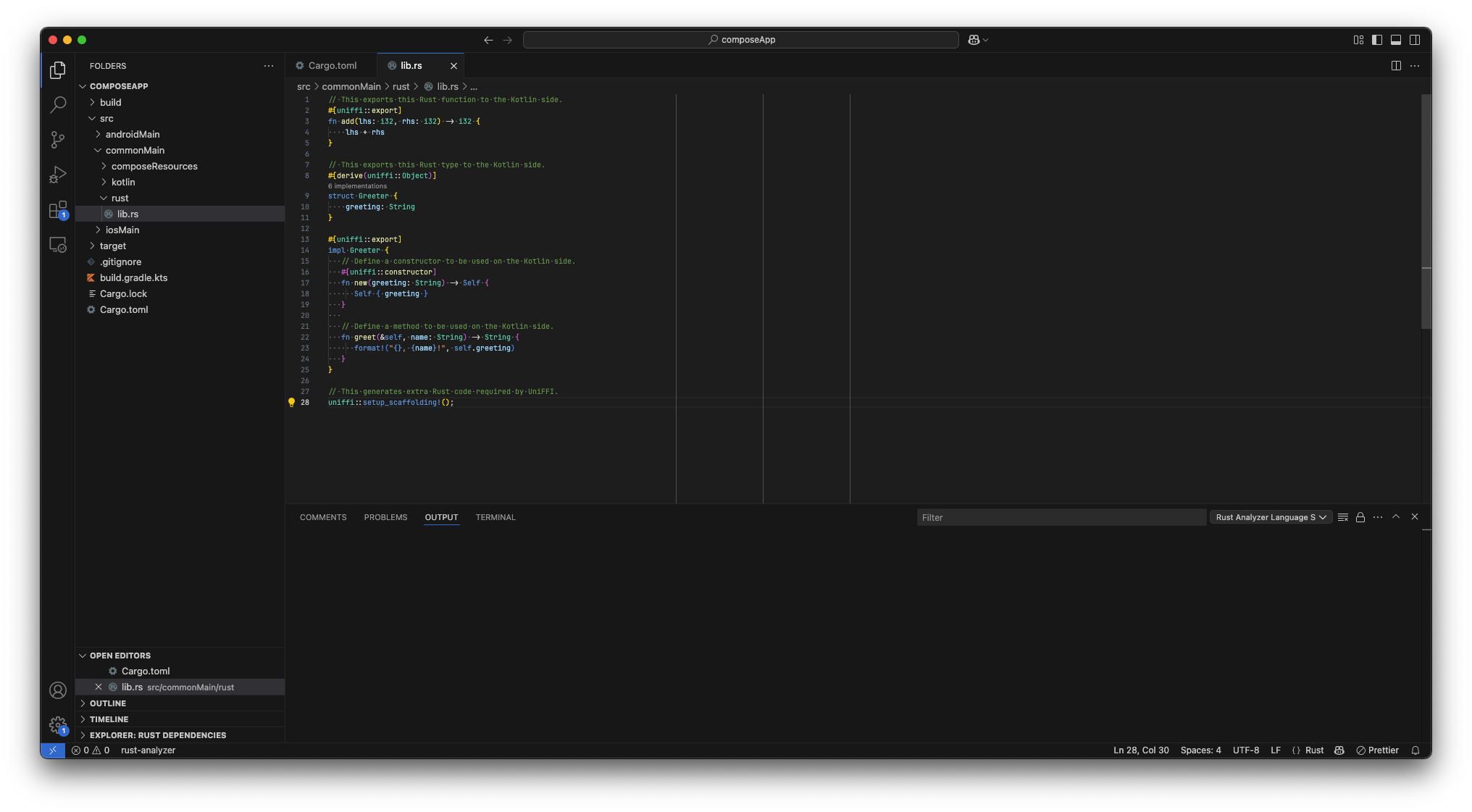
By just applying #[uniffi::export] or similar macros, the functions and the types become available
on the Kotlin side. Go back to Android Studio and run Build > Make Project. Cargo will start
building the Rust library inside Android Studio. After the build completes, open
composeApp/src/commonMain/dev/gobley/myfirstproject/App.kt. Add the following lines to the part
you prefer:
Column {
Text("Addition using Rust: 2 + 3 = ${uniffi.compose_app.add(2, 3)}")
val greeting = remember { uniffi.compose_app.Greeter("Hello") }
Text(greeting.greet("Rust"))
DisposableEffect(greeting) {
onDispose {
greeting.close()
}
}
}
Greeter and add exported on the Rust side are accessible on the Kotlin side! Doc-comments are
also available, so you don't have to write the same description twice.
Let's run the Android app. Hit the Run button on the upper right corner of the screen. You can see the Rust library is included in the final app automatically, and the app communicates with the Rust part without any issues.
Let's run the iOS app as well. Open iosApp/iosApp.xcodeproj in Xcode. Run:
open -a "Xcode" ./iosApp/iosApp.xcodeproj
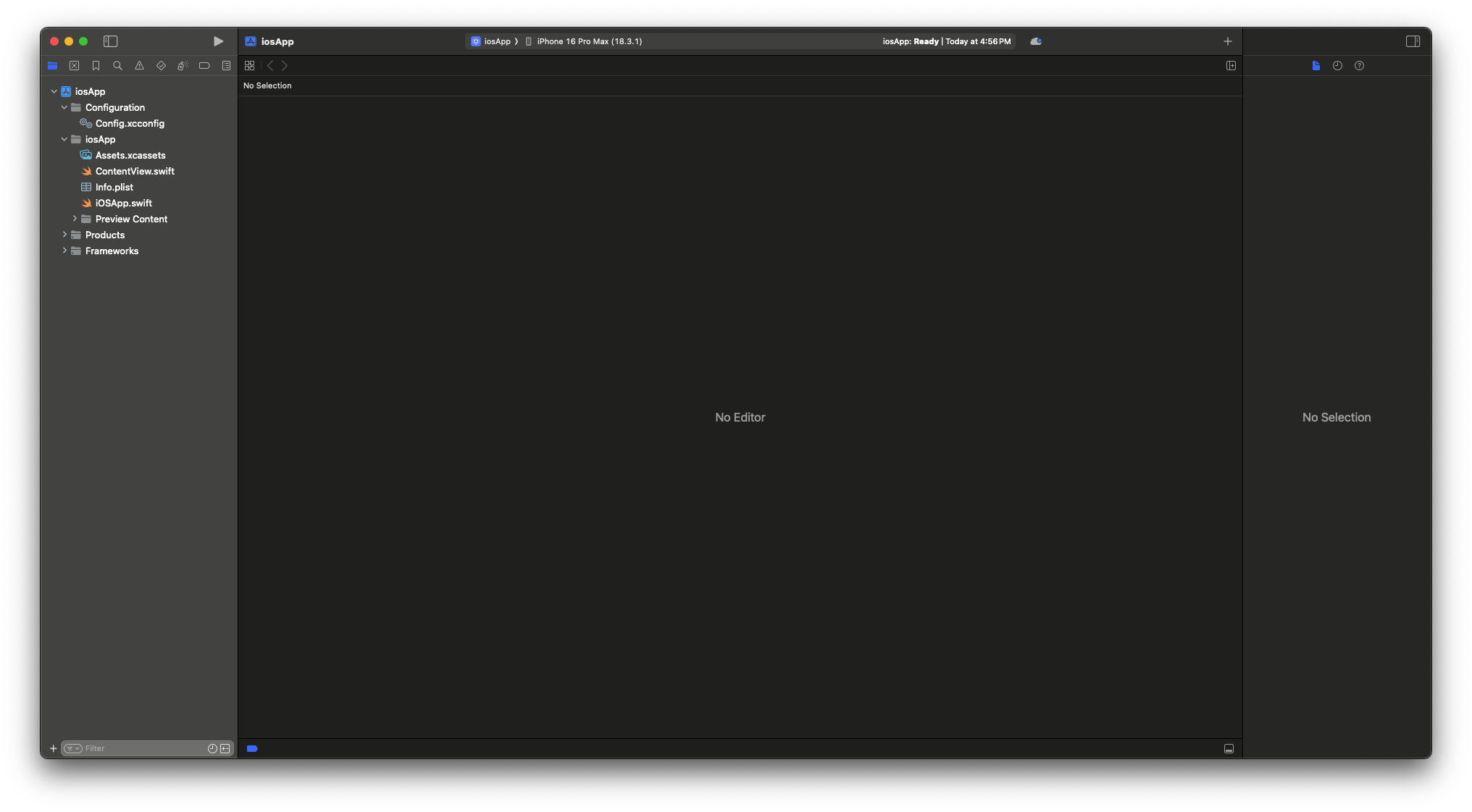
Since the part connecting Swift and Kotlin is handled by the Kotlin Multiplatform Wizard, we can just hit the Run button as well on Xcode.
| Android | iOS |
|---|---|
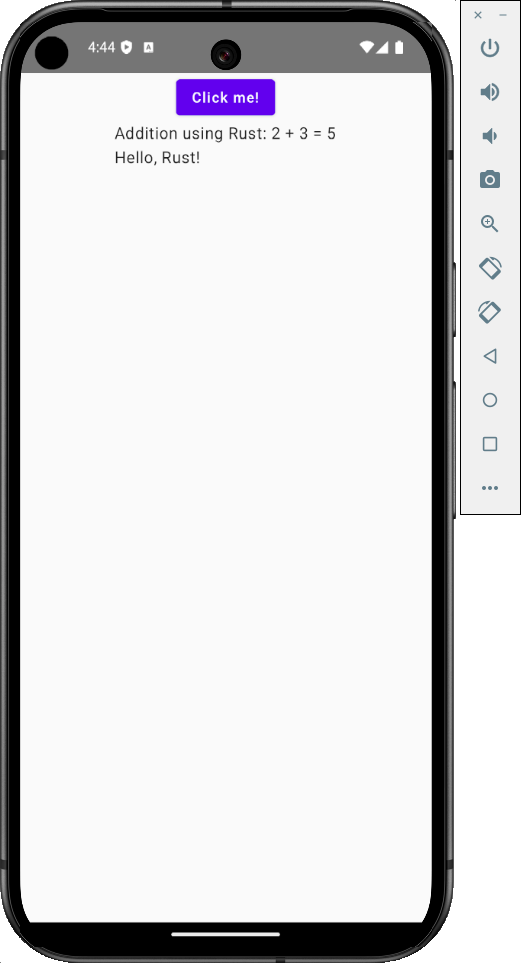 | 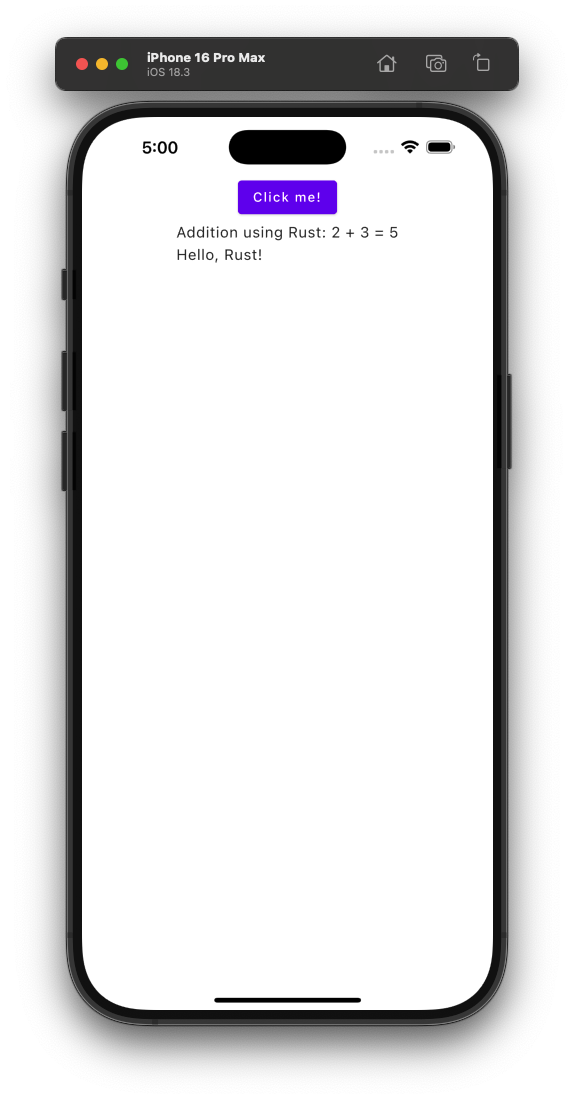 |
Next step
And that's how you embed Rust into your Kotlin project. If you need more detailed information about Gobley, please read the documentation.